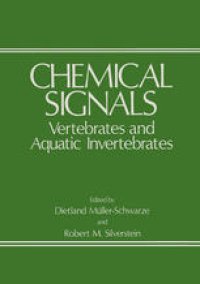
Ebook: Chemical Signals: Vertebrates and Aquatic Invertebrates
- Tags: Zoology
- Year: 1980
- Publisher: Springer US
- Edition: 1
- Language: English
- pdf
Research on chemical communication in animals is in a very active and exciting phase; more species are studied, data are accumulating, concepts are changing, and practical application seems feasible. While most of the work on chemical ecology and chemical sig nals deals with insects, vertebrate communication provides a formidable challenge and progress has been slow. Joint efforts and frequent direct contacts of ecologists, behaviorists, psychologists, physiologists, histologists and chemists are required. Such an interdisciplinary exchange of information took place on the occasion of the Symposium on Chemical Signals in Vertebrates and Aquatic Animals in Syracuse, New York, from May 31 to June 2, 1979. More than one hundred investigators from seven countries participated, and the papers presented comprise this volume. Since the first Symposium on Vertebrate Chemical Signals at Saratoga Springs in 1976, considerable progress has been made with field studies, the physiology of the vomeronasal organ, and its role in reproductive behavior. The behavioral functions and chemi cal nature of priming pheromones are better understood. Efforts to isolate and identify mammalian pheromones are gaining ground, and the bioassays are becoming more sophisticated. In addition to formal presentations, one evening of the Symposi um was devoted to round-table discussions of particular topics. The selected themes indicate the "growing points" of chemical communi cation research: priming pheromones, vomeronasal organ, bioassay, and practical applications.
Content:
Front Matter....Pages i-x
Some Responses of a Free Living Community of Rodents to the Odors of Predators....Pages 1-10
The Urine Marking Behavior and Movement Patterns of Red Foxes (Vulpes Vulpes) During a Breeding and Post-Breeding Period....Pages 11-27
Marking Behavior in Wild Red Foxes in Response to Synthetic Volatile Urinary Compounds....Pages 29-38
Chemical Signals in Alarm Behavior of Deer....Pages 39-51
Territorial Marking Behavior by the South American Vicuna....Pages 53-66
Induction of Settling and Metamorphosis of Planktonic Molluscan (Haliotis) Larvae. III: Signaling by Metabolites of Intact Algae is Dependent on Contact....Pages 67-86
Olfactory Aspects of Rutting Behavior in the Bactrian Camel (Camelus Bactrianus Ferus)....Pages 87-105
Chemosensory Searching by Rattlesnakes During Predatory Episodes....Pages 107-124
What the Nose Learns from the Mouth....Pages 125-139
Rat Pup’s Food Consumption as a Function of Preweaning Tastes and Odors....Pages 141-156
Experience Affects Behavioral Responses to Sex Odors....Pages 157-171
Development of Olfactory Attraction by Young Norway Rats....Pages 173-192
Odor Aversion Learning by Neonatal Rats: Ontogeny of Osmic Memory....Pages 193-209
The Influence of Pheromones on Puberty in Rodents....Pages 211-228
The Modulation of Reproduction by Priming Pheromones in House Mice: Speculations on Adaptive Function....Pages 229-241
The Major Histocompatibility Complex as a Source of Odors Imparting Individuality among Mice....Pages 243-265
Behavioral and Stimulus Correlates of Vomeronasal Functioning in Reptiles: Feeding, Grouping, Sex, and Tongue Use....Pages 267-273
The Vomeronasal Organ and Accessory Olfactory System in the Hamster....Pages 275-301
Chemical Communication in the Guinea Pig: Urinary Components of Low Volatility and Their Access to the Vomeronasal Organ....Pages 303-326
The Role of the Vomeronasal System in Mammalian Reproductive Physiology....Pages 327-339
Chemical Studies of Hamster Reproductive Pheromones....Pages 341-364
Chemical Studies of the Primer Mouse Pheromones....Pages 365-375
Variation in the Levels of Some Components of the Volatile Fraction of Urine from Captive Red Foxes (Vulpes Vulpes) and Its Relationships to the State of the Animal....Pages 377-390
Chemical Signals Associated with Aquatic Predation Sites....Pages 391-403
Behavioural and Electrophysiological Effects of Natural Chemical Stimuli in the Goldfish (Carassius Auratus)....Pages 405-406
Olfactory Use in Food-Location at Sea by Tubenosed Pelagic Birds....Pages 407-408
Partial Isolation of Pregnancy Block Pheromone in Mice....Pages 409-410
The Role of the Tarsal Glands in the Olfactory Communication of the Ontario Moose....Pages 411-412
Studies on Chemical Communication in Some African Bovids....Pages 413-414
Back Matter....Pages 415-415
....Pages 417-420